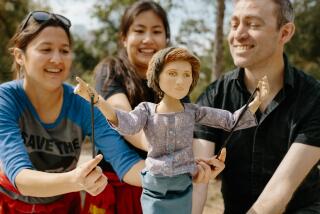Polish Pride : Folk Dancers Promote Their Culture With Entertainment
- Share via
TUSTIN — Karolina Simon could have chosen jazz or ballet like other girls who love to dance. Instead, she picked folk dancing because it gives her a sense of family.
*
Simon’s father is Hungarian, her mother is Polish, and she says her pride in her ethnic heritage has inspired her to be a folk dancer.
The El Dorado High School freshman in Placentia is the youngest member of the Gorale Polish Folk Dancers of Anaheim, the oldest Polish American dance group in Southern California. Simon says the group is “like a family.”
Last week, Simon was a 15th-Century princess in a gold-and-fur costume during the group’s two-hour show of Polish national dances at the Tustin Senior Center, where members of the Tustin Area Historical Society lustily applauded every number.
“I like entertaining people,” Simon said. “And this is a way to show off our customs.”
The Gorale Polish Dancers, named after a mountain region in Poland, was formed in 1953 to promote Polish culture through folk dancing, said the group’s director, Rick Kobzi, 41, of Anaheim.
Kobzi, who joined the group as a dancer in 1970, said they have at least 100 performances a year across California and Nevada, and have appeared in movies and special events.
“We are committed to continue spreading the Polish culture in the West,” Kobzi said. “This also gives our young people pride in their heritage.”
In addition to the dances in last week’s show, a retired Anaheim librarian, dressed in period costume, portrayed the life of Helena Modjeska, a Polish stage actress popular in San Francisco and New York in the late 1800s and early 1900s.
Before Modjeska became a Shakespearean actress, she and seven other Polish immigrants established a farming community in Anaheim in 1876. But the grape- and winemaking venture lasted just a year, forced to bankruptcy by a drought in 1877.
Opal Kissinger, who portrayed the Polish actress in last week’s show, said Modjeska became an actress at age 37 in 1877. She was considered one of the best during her time. In 1888, she moved to Tustin and settled in what is now known as Modjeska Canyon. She died in Newport Beach in 1909.
A local historian, Stephen Gould, said that in addition to Modjeska, two Polish immigrants who helped form the Anaheim farming colony later became popular--Henryk Sienkiewicz, a Nobel Prize-winning novelist, and geographer and illustrator Ludwig Louis Salvator.
The Anaheim colony “was a miserable failure because they just wanted to write poetry and hunt and not work as farmers,” Gould said.
The Polish American community in Orange County is relatively small, compared to those in Chicago, New York and other cities, Kobzi said. He said that about 1,800 Polish American families are registered with the Pope John Paul II Polish Center in Yorba Linda. The center maintains a school that allows Americans of Polish descent to learn the Polish language.
In September, Kobzi said the center celebrates the annual Dozynki, a two-day festival that recalls the harvest festival in Poland in which peasants bring their produce to the market.
“The holiday tradition is very special in Poland,” Kobzi said.
Kobzi said that members of his dance group are mostly students and young professionals, ranging in age from 15 to 47. A majority speak Polish and some have gone to Poland on their own to learn the dances of their people.
Tony Nowak-Przygodzki, 24, who has been a dancer since 1986, said that he went to Poland last year to learn the dances from the mountain region of Gorale. With his partner, Jonine Sodders, Nowak-Przygodzki dances the fast-paced oberek , which involves lifting the female partner and flipping her around the shoulders of the male partner.
“It’s a good exercise,” said a smiling Nowak-Przygodzki, a business student at Cal State Fullerton.
Tustin resident Ruth Harmon said watching the Polish dancers gave her an insight into their culture.
“It was different and unique,” said Harmon, who draws Victorian houses for a hobby. “The young people were vibrant and energetic. It’s good that they can carry on their ethnic background.”
More to Read
Sign up for Essential California
The most important California stories and recommendations in your inbox every morning.
You may occasionally receive promotional content from the Los Angeles Times.













